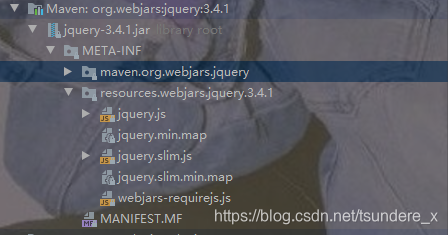SpringBoot笔记整理(一)
SpringBoot笔记整理(二)
SpringBoot笔记整理(三)
SpringBoot笔记整理(四)
Web开发
1、使用SpringBoot:
1)创建SpringBoot应用,选中需要的模块
2)SpringBoot已经默认将这些场景配置好了,只需要在配置文件中指定少量配置就可以运行起来
3)自己编写业务代码
自动配置原理
xxxAutoConfiguration:帮我们给容器中自动配置组件
xxxProperties:配置类来封装配置文件的内容
2、SpringBoot对静态资源的映射规则
@ConfigurationProperties(prefix = "spring.resources",ignoreUnknownFields = false
)
public class ResourceProperties {//可以设置和静态资源有关的参数,缓存时间等
public void addResourceHandlers(ResourceHandlerRegistry registry) {if (!this.resourceProperties.isAddMappings()) {logger.debug("Default resource handling disabled");} else {Duration cachePeriod = this.resourceProperties.getCache().getPeriod();CacheControl cacheControl = this.resourceProperties.getCache().getCachecontrol().toHttpCacheControl();if (!registry.hasMappingForPattern("/webjars/**")) {this.customizeResourceHandlerRegistration(registry.addResourceHandler(new String[]{"/webjars/**"}).addResourceLocations(new String[]{"classpath:/META-INF/resources/webjars/"}).setCachePeriod(this.getSeconds(cachePeriod)).setCacheControl(cacheControl));}String staticPathPattern = this.mvcProperties.getStaticPathPattern();if (!registry.hasMappingForPattern(staticPathPattern)) {this.customizeResourceHandlerRegistration(registry.addResourceHandler(new String[]{staticPathPattern}).addResourceLocations(WebMvcAutoConfiguration.getResourceLocations(this.resourceProperties.getStaticLocations())).setCachePeriod(this.getSeconds(cachePeriod)).setCacheControl(cacheControl));}}
}//配置欢迎页映射
@Bean
public WelcomePageHandlerMapping welcomePageHandlerMapping(ApplicationContext applicationContext, FormattingConversionService mvcConversionService, ResourceUrlProvider mvcResourceUrlProvider) {WelcomePageHandlerMapping welcomePageHandlerMapping = new WelcomePageHandlerMapping(new TemplateAvailabilityProviders(applicationContext), applicationContext, this.getWelcomePage(), this.mvcProperties.getStaticPathPattern());welcomePageHandlerMapping.setInterceptors(this.getInterceptors(mvcConversionService, mvcResourceUrlProvider));return welcomePageHandlerMapping;
}
1)所有/webjars/**,都去classpath:/META-INF/resources//webjars/找资源
webjars:以jar包的方式引入静态资源;
https://www.webjars.org/
<dependency><groupId>org.webjars</groupId><artifactId>jquery</artifactId><version>3.4.1</version>
</dependency>

2)“/**”访问当前项目的任何资源(静态资源的文件夹)
"classpath:/META-INF/resources/",
"classpath:/resources/",
"classpath:/static/",
"classpath:/public/"
"/":当前项目的根路径
3)欢迎页:静态资源文件夹下的所有index.html页面,被"/"映射
4)所有的/favicon.ico 都是在静态资源文件下找
3、模板引擎
SpringBoot推荐的Thymeleaf:语法更简单,功能更强大
3.1 引入Thymeleaf
<dependency><groupId>org.springframework.boot</groupId><artifactId>spring-boot-starter-thymeleaf</artifactId>
</dependency>
3.2 Thymeleaf使用&语法
@ConfigurationProperties(prefix = "spring.thymeleaf"
)
public class ThymeleafProperties {private static final Charset DEFAULT_ENCODING;public static final String DEFAULT_PREFIX = "classpath:/templates/";public static final String DEFAULT_SUFFIX = ".html";private boolean checkTemplate = true;private boolean checkTemplateLocation = true;private String prefix = "classpath:/templates/";private String suffix = ".html";private String mode = "HTML";//只要把html页面放在classpath:/templates/,thymeleaf就能自动渲染
使用:
3.2.1 导入thymeleaf的名称空间
<html lang="en" xmlns:th="http://www/thymeleaf.org">
3.2.2 使用thymeleaf语法
<!DOCTYPE html>
<html lang="en" xmlns:th="http://www/thymeleaf.org">
<head><meta charset="UTF-8"><title>Title</title>
</head>
<body><h1>success</h1><!--th:text 将div里面的文本内容设置为--><div th:text="${hello}">这里显示欢迎信息</div>
</body>
</html>
1)th:text:改变当前元素里面的文本内容
th:任意html属性,来替换原生属性的值

2)表达式语法
Simple expressions:Variable Expressions: ${...}Selection Variable Expressions: *{...}Message Expressions: #{...}Link URL Expressions: @{...}Fragment Expressions: ~{...}
LiteralsText literals: 'one text', 'Another one!',...Number literals: 0, 34, 3.0, 12.3,...Boolean literals: true, falseNull literal: nullLiteral tokens: one, sometext, main,...
Text operations:String concatenation: +Literal substitutions: |The name is ${name}|
Arithmetic operations:Binary operators: +, -, *, /, %Minus sign (unary operator): -
Boolean operations:Binary operators: and, orBoolean negation (unary operator): !, not
Comparisons and equality:Comparators: >, <, >=, <= (gt, lt, ge, le)Equality operators: ==, != (eq, ne)Conditional operators:If-then: (if) ? (then)If-then-else: (if) ? (then) : (else)Default: (value) ?: (defaultvalue)
Special tokens:No-Operation: _



)








)






